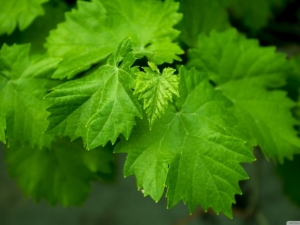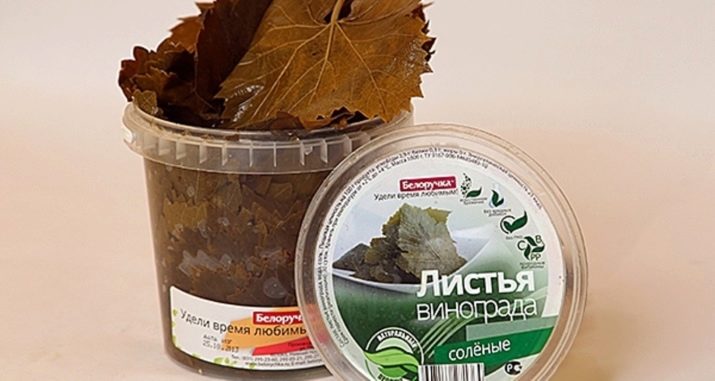Grape leaves: what is useful, where is it used and how is it harvested?

Grapes are a favorite delicacy of many people. However, not everyone knows that not only fruits, but also the leaves of this plant are useful for humans. Grape leaves are successfully used in cosmetology, cooking and in everyday life. There are many options for the use of such a product. Many of them were known in antiquity, and some gained popularity only in the modern world.
Description and composition
Grape leaves look pretty ordinary and do not stand out with any specific external characteristics. The greatest benefits come from the fresh young leaves, which have not yet become too rough. They should be as flexible as possible, with juicy streaks. It is not hard to guess that the caloric content of such a product is minimal: 100 grams of leaves contain only about 90 calories. This amount of product accounts for 2 grams of fat, about 6 grams of carbohydrates and proteins.
At the same time, the composition of grape leaves contains quite a large amount of vitamins and minerals, in particular:
- vitamins A, PP, K, B;
- sodium, copper, manganese;
- phosphorus, calcium, zinc, iron.
A small portion of grape leaves contains the daily rate of many vitamins, vital for the normal functioning of the human body.
Beneficial features
Since the grape leaves contain many useful substances, their use has a beneficial effect on many body systems.
In particular, these trace elements help:
- strengthen the walls of blood vessels;
- prevent the formation of sclerotic plaques;
- increase the body's resistance to viruses;
- improve skin quality;
- stimulate the brain;
- remove toxins from the body.
And this is not a complete list of all the positive characteristics that distinguish the leaves of wild and homemade grapes.
Contraindications
But despite the large number of useful properties, such a product in some cases can be harmful to humans.
So, it is contraindicated for those people who suffer:
- deviations in the gastrointestinal tract;
- overweight;
- diabetes mellitus.
With caution, grape leaves should be used by women during pregnancy and lactation.
Application
The scope of application of grape leaves is surprisingly wide. We list the main industries in which the leaves are used with particular success.
For treatment
If you suffer from diseases of the oral cavity, but do not want to resort to pharmaceutical drugs, grape leaves will come to your aid. They must be completely dried and how to grind. The resulting powder has excellent anti-inflammatory and antiseptic qualities. With it, any small wounds will heal much faster. You can not even cook the powder, but just chew the leaves. This will have a huge positive effect on teeth and gums.
Be sure to take a recipe like this! This medicine will not leave a single penny of money, there will be no harm from it, but you will see the benefit rather quickly.
Compresses of fresh grape leaves help to cope with excessive swelling, significantly improve blood circulation and lymph flow. This effect is achieved due to the high content of tannins in the leaves. More compresses will be an excellent addition to the complex of procedures aimed at the treatment of varicose veins and the fight against vascular networks. They contribute to the narrowing of the capillaries and reduce pain.
Juice of grape leaves also occupies a special place in alternative medicine. With it you can adjust the functioning of the gastrointestinal tract. So, it can be used for people who suffer from gastritis or ulcers. Juice helps fight nausea, stop internal bleeding, helps to normalize the level of acidity. This product also has a beneficial effect on traversing pathways.
For beauty
Grape leaves - just a real find for those who dream of the perfect skin. Even in ancient times, women used them to improve the complexion and décolleté. Grape leaves have a tonic, rejuvenating, renewing, tightening effect. Especially useful leaf maxi for people with oily skin. Leaves help normalize sebaceous glands and narrow pores. They have a peeling and polishing effect, complementing peeling. If your work involves a strong eye strain, or you just do not get enough sleep, be sure to make a compress of grape leaves. Thus, you eliminate the external signs of fatigue, swelling and redness. And the look will be more radiant and fresh.
As well as lotion from the juice of young grape leaves helps to fight excessive pigmentation of the skin of the face.
Leaflets have a beneficial effect not only on the skin, but also on the hair. Rinsing curls with decoctions based on grape leaves helps to significantly strengthen the hair, give it shine, reduce the cross section of the tips. Masks with the addition of juice stimulate hair growth, strengthen the bulbs and reduce hair loss.
In cooking
Since this product has a low calorie content, it can be added even to diet meals. The leaves are perfectly combined with fresh and smoked meat, poultry, beans, rice and even fish. The most common dish that is prepared using grape leaves is east dolma. This dish is an analogue of Russian cabbage rolls, only fresh leaves of grapes are used instead of cabbage. In salads and rolls with sheets also replace cabbage or any other greens. In some countries, this product is even added to desserts. The list of dishes is unlimited!
And if you dry the fresh leaves, chop them and brew, you get a great refreshing drink. He will give you strength and vigor.
For domestic purposes
Nature created the leaves so that they protect the fruits of the grapes from adverse conditions. But if this is not enough, you can help preserve the crop with a more practical and effective use of the leaves. To do this, mix them with small sawdust. Such material can be used not only as a plant protection, but also for its fertilizer. The land of the grapes, sprinkled with such compositions, is better preserved until the next season. And this means that the harvest will certainly please you.
Harvesting and storage
Leaflets should be collected only from healthy, unaffected branches during the flowering period of the grapes. If in your garden there is no vine, then collect the leaves only in a clean place, away from the roads and landfills. Cut the leaves completely, about a third of them should remain to provide the necessary protection for the fruit. You can store them in ordinary canvas bags. And in order to prepare the leaves for the winter, you can roll them into jars, pickle, salt and even freeze dry.
You will learn more about how to harvest grape leaves by watching the following video.
Recipes
Consider for example several options for the beneficial use of grape leaves.
Useful decoction
Preparing a healing drink that will positively affect the intestinal microflora and help strengthen the walls of blood vessels is not difficult. To do this, take about 100 grams of grape leaves, carefully sort them out and rinse, removing rotten and damaged leaves. Then put them in a small saucepan, mash a little and pour half a liter of boiling water. Place the container on low heat and simmer for about 60 minutes under a lid. Strain the obtained drink through cheesecloth or a sieve, pour it into a glass dish, cover with a lid and put it in a dark place.
Consume 2 tablespoons before meals for 3 weeks. The shelf life of such a decoction is no more than six months.
Tea
Preparing raw materials for tasty and healthy grape tea is a snap.To do this, first dry the freshly picked leaves. This can be done in several ways: with natural sunlight, in a special dryer. You can dry the leaves entirely, or you can put them in several layers. After the heat treatment is completed, you can fold the leaves for future tea in a fabric bag or box.
The main thing is not to keep raw materials where sunlight and damp penetrate.
Shred the leaves only just before brewing the drink. So it will be the most delicious, fragrant, rich and healthy. The proportions of tea leaves and boiling water should be about the same. It is necessary to insist tea for 10 minutes, after which you can drink it. Daily use of such tea helps to cope with colds and strengthen the immune system.
Salty snack
For the preparation of grape pickles should carefully prepare the leaves. Reassemble them and wash them first in a large container and then under running water. Prepare a suitable number of cans and place the leaves in tight rows. Then pour in each jar a solution that consists of water and salt in the ratio of 1 liter per 100 grams. Tighten the cap tightly and place the jar in hot water for half a minute. Then check the tightness of the lid closed, cool the jar and place the canned dish in the refrigerator or cellar. Marinated salted leaves will be an excellent addition to the pilaf, meat, pastries.
Dolma
To date, there are many recipes for this delicious dish, but we consider the classic version of its preparation. You will need fresh grape leaves and high-quality meat. Perfect minced beef, pork, lamb. You can even use chicken. Prepare a pound of meat, 2 onions, a couple of garlic cloves, 100 grams of long-grain rice, as well as salt, greens and spices to taste. Mix all ingredients thoroughly. Then dip the grape leaves for a few minutes in boiling water before darkening their color to increase their softness and elasticity.
Place a small amount of minced meat with rice and spices in the middle of the leaflet and wrap the stuffing into the leaf one by one from the bottom. Do this procedure with all the stuffing. Next, line a layer of grape foliage at the bottom of the pan, forming a kind of pillow. And already on it lay out the future dolma. Pour the contents of the pan with water, put the container on medium heat and cook the dish for about 40 minutes. This simple, but very interesting and tasty recipe for an unusual dish has won the hearts of people around the world. Be sure to try!
Cheese in grape leaves
If you are looking for a recipe for a vegetarian dish with grape foliage, then we suggest you try this one. You need about 400 grams of hard cheese, 50 ml of melted butter, about 20 leaves, a little honey, garlic and paprika. Cut the cheese into small slices or slices and completely wrap it in foliage. Then fry the envelopes in butter for just a few minutes. Next, prepare the sauce from paprika, honey and garlic. Serve meals together.
These are not all possible recipes that can be made from the leaves of grapes. So do not be afraid to experiment, discover all the new tastes!





































